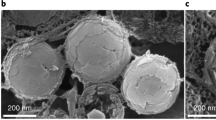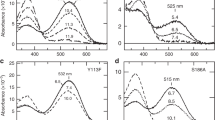Abstract
Animals make use of a wealth of optical physics to control and manipulate light, for example, in creating reflective animal colouration1,2,3 and polarized light signals4. Their precise optics often surpass equivalent man-made optical devices in both sophistication and efficiency5. Here, we report a biophysical mechanism that creates a natural full-visible-range achromatic quarter-wave retarder in the eye of a stomatopod crustacean. Analogous, man-made retardation devices are important optical components, used in both scientific research and commercial applications for controlling polarized light. Typical synthetic retarders are not achromatic, and more elaborate designs, such as, multilayer subwavelength gratings or bicrystalline constructions, only achieve partial wavelength independence6. In this work, we use both experimental measurements and theoretical modelling of the photoreceptor structure to illustrate how a novel interplay of intrinsic and form birefringence results in a natural achromatic optic that significantly outperforms current man-made optical devices.
This is a preview of subscription content, access via your institution
Access options
Subscribe to this journal
Receive 12 print issues and online access
$209.00 per year
only $17.42 per issue
Buy this article
- Purchase on Springer Link
- Instant access to full article PDF
Prices may be subject to local taxes which are calculated during checkout




Similar content being viewed by others
References
Vukusic, P. & Hooper, I. Directionally controlled fluorescence emission in butterflies. Science 310, 1151 (2005).
Vukusic, P., Sambles, J. R. & Lawrence, C. R. Structural colour—colour mixing in wing scales of a butterfly. Nature 404, 457 (2000).
Sutherland, R. L., Mathger, L. M., Hanlon, R. T., Urbas, A. M. & Stone, M. O. Cephalopod coloration model. I. Squid chromatophores and iridophores. J. Opt. Soc. Am. A 25, 588–599 (2008).
Cronin, T. W. et al. Polarization vision and its role in biological signaling. Integr. Comparat. Biol. 43, 549–558 (2003).
Vukusic, P. & Sambles, J. R. Photonic structures in biology. Nature 424, 852–855 (2003).
Kikuta, H., Ohira, Y. & Iwata, K. Achromatic quarter-wave plates using the dispersion of form birefringence. Appl. Opt. 36, 1566–1572 (1997).
Morris, R. B. Iridescence from diffraction structures in the wing scales of Callophrys rubi, the green hairstreak. J. Entomol. A 49, 149–154 (1975).
Parker, A. R., Welch, V. L., Driver, D. & Martini, N. Structural colour—opal analogue discovered in a weevil. Nature 426, 786–787 (2003).
Vigneron, J. P. et al. Switchable reflector in the Panamanian tortoise beetle Charidotella egregia (Chrysomelidae:Cassidinae). Phys. Rev. E 76, 031907 (2007).
Vukusic, P., Sambles, J. R., Lawrence, C.R. & Wotton R. J. Structural colour—now you see it now you don't. Nature 410, 36 (2001).
Cuthill, I. C. et al. Disruptive coloration and background pattern matching. Nature 434, 72–74 (2005).
Endler, J. A. On the measurement and classification of color in studies of animal color patterns. Biol. J. Linn. Soc. 41, 315–352 (1990).
Roberts, N. W. & Needham, M. G. A mechanism of polarized light sensitivity in cone photoreceptors of the goldfish Carassius auratus. Biophys. J. 93, 3241–3248 (2007).
Marshall, N. J. et al. The compound eyes of mantis shrimps (Crustacea, Hoplocarida, Stomatopoda). 1. Compound eye structure—the detection of polarized light. Philos. Trans. Roy. Soc. B 334, 33–56 (1991).
Marshall, N. J., Cronin, T. W., Shashar, N. & Land, M. Behavioural evidence for polarisation vision in stomatopods reveals a potential channel for communication. Curr. Biol. 9, 755–758 (1999).
Chiou, T.-H. et al. Circular polarization vision in a stomatopod crustacean. Curr. Biol. 18, 429–434 (2008).
Marshall, N. J. et al. The compound eyes of mantis shrimps (Crustacea, Hoplocarida, Stomatopoda). 2. Color pigments in the eyes of stomatopod crustaceans—polychromatic vision by serial and lateral filtering. Philos. Trans. Roy. Soc. B 334, 57–84 (1991).
Tilsch, M. K. et al. Production scale deposition of multilayer film structures for birefringent optical components. Thin Solid Films 516, 107–113 (2007).
Kirschfeld, K. & Snyder, A. W. Photoreceptor Optics 56–77 (Springer, 1975).
Bêche, B. & Gaviot, E. Matrix formalism to enhance the concept of effective dielectric constant. Opt. Commun. 219, 15–19 (2003).
Roberts, N. W. & Gleeson, H. F. The absorption of polarized light by vertebrate photoreceptors. Vision Res. 44, 2643–2652 (2004).
Roberts, N. W. The optics of vertebrate photoreceptors: anisotropy and form birefringence. Vision Res. 46, 3259–3266 (2006).
Wehner, R., Bernard, G. D. & Geiger, E. Twisted and non-twisted rhabdoms and their significance for polarization detection in the bee. J. Comp. Physiol. 104, 225–245 (1975).
Snyder, A. W. & McIntyre, P. Photoreceptor Optics 338–391 (Springer, 1975).
Yi, D. E., Yan, Y. B., Liu, H. T., Si-Lu & Jin, G. F. Broadband achromatic phase retarder by subwavelength grating. Opt. Commun. 227, 49–55 (2003).
Gaillot, D. P. et al. Composite organic–inorganic butterfly scales: production of photonic structures with atomic layer deposition. Phys. Rev. E 78, 031922 (2008).
Valentine, J. et al. Three-dimensional optical metamaterial with a negative refractive index. Nature 455, 376–379 (2008).
Vukusic, P., Hallam, B. & Noyes, J. Brilliant whiteness in ultrathin beetle scales. Science 315, 348 (2007).
Cronin, T. W., Marshall, N. J. & Caldwell, R. L. Visual pigment diversity in two genera of mantis shrimps implies rapid evolution (Crustacea; Stomatopoda). J. Comp. Physiol. A 179, 371–384 (1996).
Jenkins, F. A. & White, H. E. Fundamentals of Optics 4th edn, 482 (McGraw-Hill International Editions, 1981).
Acknowledgements
This work was supported by grants from the Air Force Office of Scientific Research, the Engineering and Physical Sciences Research Council (EPSRC), the Asian Office of Aerospace Research and Development, the Australian Research Council and the National Science Foundation.
Author information
Authors and Affiliations
Contributions
All authors contributed extensively to all aspects of the work presented in this paper.
Corresponding author
Rights and permissions
About this article
Cite this article
Roberts, N., Chiou, TH., Marshall, N. et al. A biological quarter-wave retarder with excellent achromaticity in the visible wavelength region. Nature Photon 3, 641–644 (2009). https://doi.org/10.1038/nphoton.2009.189
Received:
Accepted:
Published:
Issue Date:
DOI: https://doi.org/10.1038/nphoton.2009.189
This article is cited by
-
Polarization-sensitive optoionic membranes from chiral plasmonic nanoparticles
Nature Nanotechnology (2022)
-
Solution-processed inorganic perovskite crystals as achromatic quarter-wave plates
Nature Photonics (2021)
-
Achromatic optical waveplates based on cellulose nanocrystals
Cellulose (2021)
-
Nanotechnology in a shrimp eye’s view
Nature Nanotechnology (2020)
-
Circularly polarized lanthanide luminescence for advanced security inks
Nature Reviews Chemistry (2020)



